Ellagic Acid and Cancer Hallmarks: Insights from Experimental Evidence
- PMID: 38002335
- PMCID: PMC10669545
- DOI: 10.3390/biom13111653
Ellagic Acid and Cancer Hallmarks: Insights from Experimental Evidence
Abstract
Cancer is a complex and multifaceted disease with a high global incidence and mortality rate. Although cancer therapy has evolved significantly over the years, numerous challenges persist on the path to effectively combating this multifaceted disease. Natural compounds derived from plants, fungi, or marine organisms have garnered considerable attention as potential therapeutic agents in the field of cancer research. Ellagic acid (EA), a natural polyphenolic compound found in various fruits and nuts, has emerged as a potential cancer prevention and treatment agent. This review summarizes the experimental evidence supporting the role of EA in targeting key hallmarks of cancer, including proliferation, angiogenesis, apoptosis evasion, immune evasion, inflammation, genomic instability, and more. We discuss the molecular mechanisms by which EA modulates signaling pathways and molecular targets involved in these cancer hallmarks, based on in vitro and in vivo studies. The multifaceted actions of EA make it a promising candidate for cancer prevention and therapy. Understanding its impact on cancer biology can pave the way for developing novel strategies to combat this complex disease.
Keywords: cancer; chemoprevention; chemotherapy; ellagic acid; hallmarks.
Conflict of interest statement
The authors declare no conflict of interest.
Figures


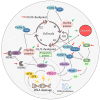

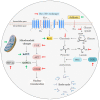
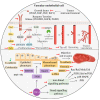
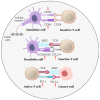
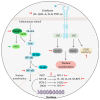
Similar articles
-
Ellagic Acid Inhibits Bladder Cancer Invasiveness and In Vivo Tumor Growth.Nutrients. 2016 Nov 22;8(11):744. doi: 10.3390/nu8110744. Nutrients. 2016. PMID: 27879653 Free PMC article.
-
Ellagic acid-loaded, tween 80-coated, chitosan nanoparticles as a promising therapeutic approach against breast cancer: In-vitro and in-vivo study.Life Sci. 2021 Nov 1;284:119927. doi: 10.1016/j.lfs.2021.119927. Epub 2021 Sep 4. Life Sci. 2021. PMID: 34492262
-
The Effects of Ellagic Acid upon Brain Cells: A Mechanistic View and Future Directions.Neurochem Res. 2016 Jun;41(6):1219-28. doi: 10.1007/s11064-016-1853-9. Epub 2016 Feb 4. Neurochem Res. 2016. PMID: 26846140 Review.
-
MDM2 as a target for ellagic acid‑mediated suppression of prostate cancer cells in vitro.Oncol Rep. 2020 Sep;44(3):1255-1265. doi: 10.3892/or.2020.7664. Epub 2020 Jun 26. Oncol Rep. 2020. PMID: 32705219
-
Experimental Evidence of the Antitumor, Antimetastatic and Antiangiogenic Activity of Ellagic Acid.Nutrients. 2018 Nov 14;10(11):1756. doi: 10.3390/nu10111756. Nutrients. 2018. PMID: 30441769 Free PMC article. Review.
Cited by
-
Comprehensive pharmacokinetic profiling and molecular docking analysis of natural bioactive compounds targeting oncogenic biomarkers in breast cancer.Sci Rep. 2025 Feb 13;15(1):5426. doi: 10.1038/s41598-024-84401-4. Sci Rep. 2025. PMID: 39948091 Free PMC article.
-
Exploring the Epigenetic and Metabolic Pathways for Antioxidant and Anti-Inflammatory Potentials of Tart Cherry Juice Concentrate.Curr Pharmacol Rep. 2025;11(1):43. doi: 10.1007/s40495-025-00422-1. Epub 2025 Jul 26. Curr Pharmacol Rep. 2025. PMID: 40727248 Free PMC article. Review.
-
Utilizing Indigenous Flora in East Africa for Breast Cancer Treatment: An Overview.Anticancer Agents Med Chem. 2025;25(2):99-113. doi: 10.2174/0118715206338557240909081833. Anticancer Agents Med Chem. 2025. PMID: 39297456 Review.
-
Design and Optimization of a Second-Generation Extruded Snack Using Carrot Waste, Blue Corn Flour, and Ellagic Acid as Functional Ingredients.Foods. 2025 May 8;14(10):1657. doi: 10.3390/foods14101657. Foods. 2025. PMID: 40428437 Free PMC article.
-
Molecular Docking Appraisal of Pleurotus ostreatus Phytochemicals as Potential Inhibitors of PI3K/Akt Pathway for Breast Cancer Treatment.Bioinform Biol Insights. 2025 Feb 3;19:11779322251316864. doi: 10.1177/11779322251316864. eCollection 2025. Bioinform Biol Insights. 2025. PMID: 39906062 Free PMC article.
References
-
- WHO Noncommunicable Diseases. 2023. [(accessed on 16 September 2023)]. Available online: https://www.who.int/news-room/fact-sheets/detail/noncommunicable-diseases.
-
- Bidram E., Esmaeili Y., Ranji-Burachaloo H., Al-Zaubai N., Zarrabi A., Stewart A., Dunstan D.E. A concise review on cancer treatment methods and delivery systems. J. Drug Deliv. Sci. Technol. 2019;54:101350. doi: 10.1016/j.jddst.2019.101350. - DOI
-
- Budreviciute A., Damiati S., Sabir D.K., Onder K., Schuller-Goetzburg P., Plakys G., Katileviciute A., Khoja S., Kodzius R. Management and Prevention Strategies for Non-communicable Diseases (NCDs) and Their Risk Factors. Front. Public Health. 2020;8:574111. doi: 10.3389/fpubh.2020.574111. - DOI - PMC - PubMed
Publication types
MeSH terms
Substances
Grants and funding
- APVV-16-0446/Slovak Research and Development Agency
- VEGA 1/0539/21/Grant Agency of the Ministry of the Education,Science, Research and Sport of the Slovak Repub-lic
- VEGA 1/0513/21/Grant Agency of the Ministry of the Education,Science, Research and Sport of the Slovak Repub-lic
- VEGA 1/0446/22/Grant Agency of the Ministry of the Education,Science, Research and Sport of the Slovak Repub-lic
- OPENMED; ITMS2014+: 313011V455/European Regional Development Fund
LinkOut - more resources
Full Text Sources
Medical

